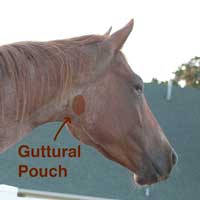ON GUARD: Guttural Pouch InfectionsBy Kenton H. Arnold, DVM
Your horse has a thick nasal discharge that won't go away. He gets better for a few days only to have the heavy nasal discharge return again. Or maybe your horse has difficulty swallowing his food, yet his teeth have been checked and no problems were found. Or your horse has a nose bleed for no apparent reason. In each of these cases, the horse could have a guttural pouch infection. Although guttural pouch infections are not common, they do occur often enough that you as a horse owner should know what the guttural pouch is and what kind of problems might occur from an infection in this area. The guttural pouch is a blind pouch or diverticulum of the auditive tube. In both, humans and horses this tube comes from the inner ear and opens into the pharynx. A small flap covers the opening of the auditive tube. The flap opens during swallowing allowing the pressure to equalize on both sides of the eardrum. In the horse, the guttural pouch just inside the flap of the audutive tube. Its function is not totally understood, but it is believed that it evolved due to the elongated mouth and pharynx of the horse to aid in swallowing. Because it is a dark, warm, moist environment, the guttural pouch creates an ideal place for both bacteria and fungi to thrive. Even so, guttural pouch inflections usually occur in conjunction with an upper respiratory problem, such as Strangles. The guttural pouch infection can continue long after the upper respirator infection has resolved. Symptoms may vary from case to case, but can include chronic nasal discharge from one or both nostrils, a swelling of the throat latch area, coughing, difficulty. Many times the symptoms are very mind and go completely unnoticed for a while. Diagnosis can be confirmed with radiographs or an endoscopic exam of the nasopharynx. Treatment requires drainage and flushing of the pouches. Usually this can be accomplished with a catheter passed though the nose and directly into the pouch. Occasionally the pus in the pouch may dry and harden, forming small hard stones called chondroids. These irrating foreign bodies should be removed surgically. Fungal infections are the most common of all the guttural pouch infections. The symptoms are the same. But usually milder. They may also cause spontaneous bleeding from the nose for no apparent reason. The internal carotid artery as well as the cranial nerves runs along the guttural pouch wall. Irritation of any of the cranial nerves can cause damage to the nerve creating problems such as difficulty swallowing to eye problems. Any horse that has a spontaneous nose bleeds or any facial paralysis for an unknown reason should be examined for a possible guttural pouch fungal infection. Treatment will include flushing the pouch and allowing fresh air ventilation through the catheter. If nerve damage has occurred, the nerve function may never return to normal. Fortunately, these infections are not common. An early diagnosis is critical to protest your horse from life-threatening symptoms involving the structures of the head, such as the nose and mouth, eyes and ears, an endoscopic exam to the guttural pouches is warranted.
Equine Veterinary Services
|


©2023 Website Design and Photos by Jim Arnold,
Carroll Brown Arnold and Austria C. Arnold
